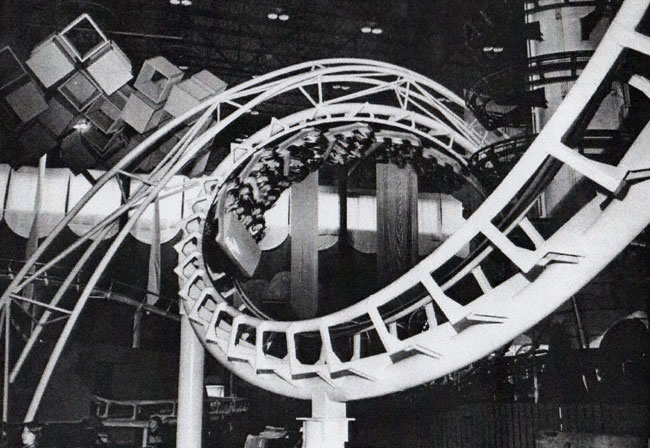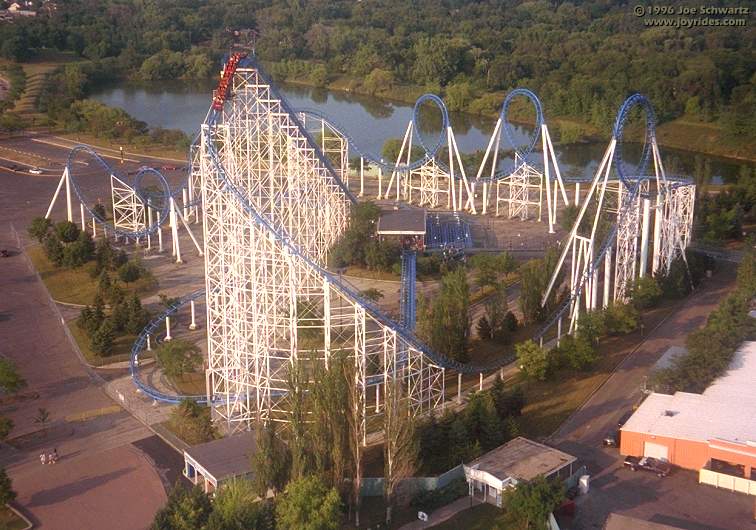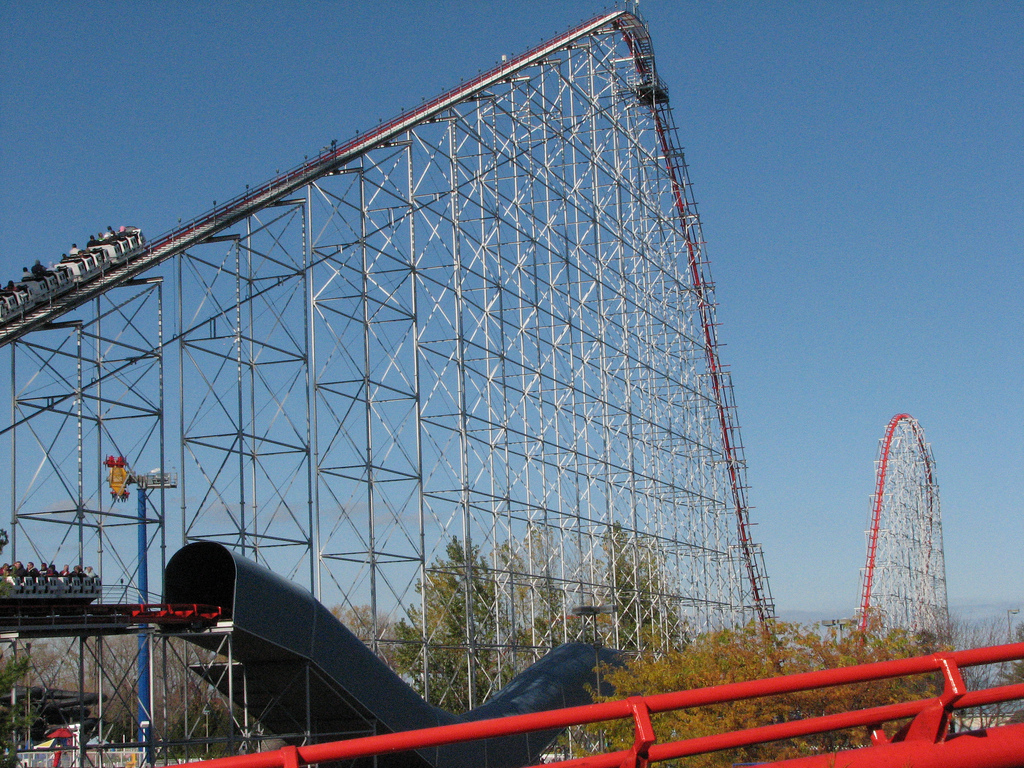September 21 marks the one year anniversary of Ron Toomer's passing. Many coaster enthusiasts and park goers have probably ridden a Toomer designed coaster, most likely unknowingly. It's fair to say that Toomer was the greatest roller coaster designer of all time, rivaled only by John C. Allen. Toomer helped guide the amusement park industry during a fundamental shift in park design and roller coaster engineering. Like Steve Jobs and Apple were to personal computing, so too was Toomer to the roller coaster.

Ron Toomer was hired by Arrow Development in 1965, a time when many amusement parks began setting their sights on the use of steel tubular track. This track offered a far smoother ride than wooden coaster track, and allowed for more dynamic roller coaster design.

Before 1965, the only steel tubular track we had seen was on Matterhorn Bobsleds at Disneyland, which Arrow too was responsible for building. Arrow had created a new market for roller coasters, and Toomer would help in its development.

Toomer's first project was Runaway Mine Train at Six Flags Over Texas. A very modest roller coaster by today's standards, but at the time was a first of its kind mine train-style roller coaster. Runaway Mine Train sparked a large takeoff with countless Arrow Mine Trains being installed throughout various parks. Fifteen were built in total, with all but one operating today - there are few roller coaster genres that can boast such a reception and sustainment. More importantly, it introduced the amusement park industry as a whole to the new ride experience that could be accomplished with steel tubular track.

But Toomer isn't known for his design of family coasters. We revere his boldness and vision with where he pushed roller coasters next - inversions. Lots of inversions.
After years of development and design, Toomer introduced the world to the modern day inversion with the Roarin' 20s Corkscrew at Knott's Berry Farm (now Corkscrew at Silverwood). Featuring two corkscrew elements, this ride design was mind blowing, wowing visitors and critics alike. The smoothness and speed with which the inversions were executed was unheard of, and turned out to only be humble beginnings for Toomer's later Arrow loopers. Toomer's inversion designs were so unchallenged, that he not only claimed the world record for most inversions once with the Roarin' 20s, but broke that same record five times.

That isn't to say that all of Toomer's designs went without flaws. Shockwave at Six Flags Great America for example opened as the world's tallest and fastest roller coaster (also with the most inversions). It was known to be an intense ride, but pushed equipment to stress limits that constantly required repair and rider discomfort. Six Flags eventually removed the ride. But Toomer took roller coaster design to literal new heights that had never been thought possible.

Toomer not only built roller coasters with inversions, but created new ways of riding. The first modern day steeplechase coaster and suspended swinging coaster both fell under his work. He is also credited with being the first to build interlocking vertical loops or a Batwing (then called Kamikaze Curve) inversion.

Toomer was also a huge influence in building coasters with speed and height. Most famously, Toomer's crown jewel was Magnum XL-200 at Cedar Point - the tallest and fastest roller coaster when it opened in 1989, and the first to break the 200 ft. mark. Right next door to Magnum is Gemini, Arrow's only racing roller coaster, which too was the tallest and fastest roller coaster at 118 ft. when it opened in 1979.

Toomer had contributions beyond the roller coaster realm. Though coaster design was the bulk of his projects, he also helped out with Arrow's log flume designs. During his time with Arrow, the company had been purchased by the famous thrill ride manufacturer Huss and had taken the name Arrow-Huss. Toomer was instrumental in the buyout of Huss in 1986, allowing Arrow to regain its independence once again as Arrow Dynamics, of which he was appointed chairman. Toomer eventually retired in 1998, but still remained as a consultant for the company.

Though Ron Toomer has passed away and Arrow Dynamics diminished by bankruptcy and purchase, there is no denying the impact Toomer and Arrow Dynamics had on roller coaster design. To say he is missed is overstated - just visit your nearest amusement park and you will undoubtedly find his work still intact.

Ron Toomer was hired by Arrow Development in 1965, a time when many amusement parks began setting their sights on the use of steel tubular track. This track offered a far smoother ride than wooden coaster track, and allowed for more dynamic roller coaster design.

Before 1965, the only steel tubular track we had seen was on Matterhorn Bobsleds at Disneyland, which Arrow too was responsible for building. Arrow had created a new market for roller coasters, and Toomer would help in its development.

Toomer's first project was Runaway Mine Train at Six Flags Over Texas. A very modest roller coaster by today's standards, but at the time was a first of its kind mine train-style roller coaster. Runaway Mine Train sparked a large takeoff with countless Arrow Mine Trains being installed throughout various parks. Fifteen were built in total, with all but one operating today - there are few roller coaster genres that can boast such a reception and sustainment. More importantly, it introduced the amusement park industry as a whole to the new ride experience that could be accomplished with steel tubular track.

But Toomer isn't known for his design of family coasters. We revere his boldness and vision with where he pushed roller coasters next - inversions. Lots of inversions.
After years of development and design, Toomer introduced the world to the modern day inversion with the Roarin' 20s Corkscrew at Knott's Berry Farm (now Corkscrew at Silverwood). Featuring two corkscrew elements, this ride design was mind blowing, wowing visitors and critics alike. The smoothness and speed with which the inversions were executed was unheard of, and turned out to only be humble beginnings for Toomer's later Arrow loopers. Toomer's inversion designs were so unchallenged, that he not only claimed the world record for most inversions once with the Roarin' 20s, but broke that same record five times.

That isn't to say that all of Toomer's designs went without flaws. Shockwave at Six Flags Great America for example opened as the world's tallest and fastest roller coaster (also with the most inversions). It was known to be an intense ride, but pushed equipment to stress limits that constantly required repair and rider discomfort. Six Flags eventually removed the ride. But Toomer took roller coaster design to literal new heights that had never been thought possible.

Toomer not only built roller coasters with inversions, but created new ways of riding. The first modern day steeplechase coaster and suspended swinging coaster both fell under his work. He is also credited with being the first to build interlocking vertical loops or a Batwing (then called Kamikaze Curve) inversion.

Toomer was also a huge influence in building coasters with speed and height. Most famously, Toomer's crown jewel was Magnum XL-200 at Cedar Point - the tallest and fastest roller coaster when it opened in 1989, and the first to break the 200 ft. mark. Right next door to Magnum is Gemini, Arrow's only racing roller coaster, which too was the tallest and fastest roller coaster at 118 ft. when it opened in 1979.

Toomer had contributions beyond the roller coaster realm. Though coaster design was the bulk of his projects, he also helped out with Arrow's log flume designs. During his time with Arrow, the company had been purchased by the famous thrill ride manufacturer Huss and had taken the name Arrow-Huss. Toomer was instrumental in the buyout of Huss in 1986, allowing Arrow to regain its independence once again as Arrow Dynamics, of which he was appointed chairman. Toomer eventually retired in 1998, but still remained as a consultant for the company.

Though Ron Toomer has passed away and Arrow Dynamics diminished by bankruptcy and purchase, there is no denying the impact Toomer and Arrow Dynamics had on roller coaster design. To say he is missed is overstated - just visit your nearest amusement park and you will undoubtedly find his work still intact.
